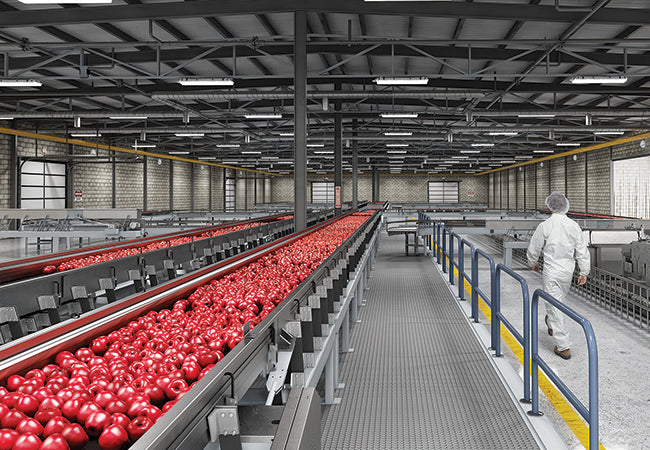
Food Processing Lighting
Choosing the right lighting for food processing facilities can be a difficult task to undertake. The many locations within food processing plants, and their differing uses, bring with them different lighting requirements. As with emergency lighting, there are a number of regulating agencies that set requirements and standards. The National Sanitation Foundation (NSF) and US Department of Agriculture (USDA) are two such agencies that address different aspects of food processing lighting. NSF/ANSI Standard 2 (NSF 2) specifies lighting needs based on three distinct zones within a food processing plant.
| NSF/ANSI Standard 2 | Zone Description | Lighting Applications |
|---|---|---|
| Non-Food Zone | Exposure: – No direct contact with food products – Cleaning solvents Design considerations: – Resistance to cleaning solvents (lens, housing, etc.) – Glass breakage |
Kitchens Food storage Dry process areas Damp process areas |
| Splash Zone | Exposure: – No direct contact with food products – High-pressure wash-downs Design considerations: – Durable and water-shedding – Resistance to harsh cleaning solvents – Glass breakage |
Wet or damp process areas High-pressure purging or decontamination used Areas using hose wash-downs |
| Food Zone | Exposure: – Direct contact with food products – Full sanitation required |
N/A |
As most lighting products do not come into direct contact with food, the categories of Non-Food Zone or Splash Zone apply. A key difference between the two zones is in what they are exposed to, as the chart on the right shows. Non-food zone fixtures are mainly exposed to cleaning solvents rather than the high-pressure wash-downs splash-zone fixtures receive. Though both need to be made of tough materials, this difference is important to remember when choosing food processing lighting.


The use of a particular space also determines the required light intensity of fixtures. Processing rooms where employees work with equipment such as knives, slicers, grinders or saws require higher illumination to ensure safety; food inspection and color-grading areas especially require higher illumination. In these areas, the USDA requires a CRI of 85, and at least 70 in general food-processing areas. With these main requirements in mind, there are several available lighting options for non-food zones and splash-zones.
Non-food zone lighting
Non-food zones include locations such as kitchens, dry and damp processing areas. These areas require fixtures providing sufficient light for these tasks, while withstanding exposure to cleaning solvents. The options below can effectively serve such environments, guaranteeing safety. Though not all are listed as NSF certified, fixtures with a UL Damp Location rating are sufficient substitutes in terms of safety and performance.



Splash zone lighting
Areas using hose wash-downs or high-pressure purging or decontamination fall under the splash zone category. Some of the necessary components of fixtures in this zone include water-shedding capabilities and resistance to harsh cleaning solvents. Some of the options below are specifically NSF certified, while others have a UL Damp Location or Wet Location rating. Fixtures with these ratings can effectively meet the needs of safety and performance in splash zones.



